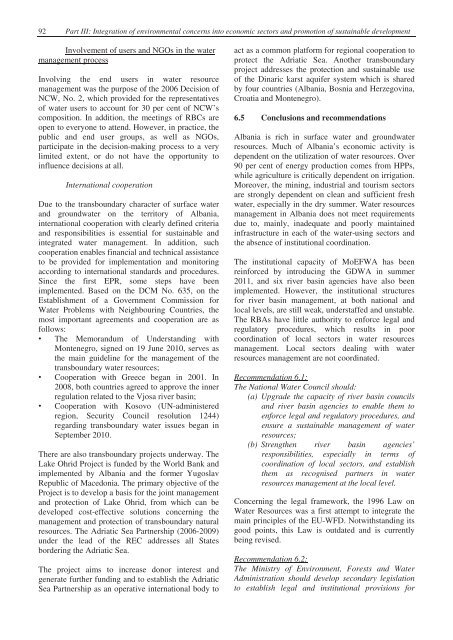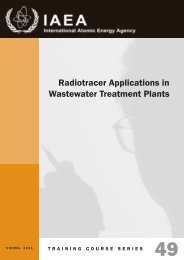Second Environmental Performance Review of Albania
Second Environmental Performance Review of Albania
Second Environmental Performance Review of Albania
You also want an ePaper? Increase the reach of your titles
YUMPU automatically turns print PDFs into web optimized ePapers that Google loves.
92 Part III: Integration <strong>of</strong> environmental concerns into economic sectors and promotion <strong>of</strong> sustainable developmentInvolvement <strong>of</strong> users and NGOs in the watermanagement processInvolving the end users in water resourcemanagement was the purpose <strong>of</strong> the 2006 Decision <strong>of</strong>NCW, No. 2, which provided for the representatives<strong>of</strong> water users to account for 30 per cent <strong>of</strong> NCW’scomposition. In addition, the meetings <strong>of</strong> RBCs areopen to everyone to attend. However, in practice, thepublic and end user groups, as well as NGOs,participate in the decision-making process to a verylimited extent, or do not have the opportunity toinfluence decisions at all.International cooperationDue to the transboundary character <strong>of</strong> surface waterand groundwater on the territory <strong>of</strong> <strong>Albania</strong>,international cooperation with clearly defined criteriaand responsibilities is essential for sustainable andintegrated water management. In addition, suchcooperation enables financial and technical assistanceto be provided for implementation and monitoringaccording to international standards and procedures.Since the first EPR, some steps have beenimplemented. Based on the DCM No. 635, on theEstablishment <strong>of</strong> a Government Commission forWater Problems with Neighbouring Countries, themost important agreements and cooperation are asfollows:• The Memorandum <strong>of</strong> Understanding withMontenegro, signed on 19 June 2010, serves asthe main guideline for the management <strong>of</strong> thetransboundary water resources;• Cooperation with Greece began in 2001. In2008, both countries agreed to approve the innerregulation related to the Vjosa river basin;• Cooperation with Kosovo (UN-administeredregion, Security Council resolution 1244)regarding transboundary water issues began inSeptember 2010.There are also transboundary projects underway. TheLake Ohrid Project is funded by the World Bank andimplemented by <strong>Albania</strong> and the former YugoslavRepublic <strong>of</strong> Macedonia. The primary objective <strong>of</strong> theProject is to develop a basis for the joint managementand protection <strong>of</strong> Lake Ohrid, from which can bedeveloped cost-effective solutions concerning themanagement and protection <strong>of</strong> transboundary naturalresources. The Adriatic Sea Partnership (2006-2009)under the lead <strong>of</strong> the REC addresses all Statesbordering the Adriatic Sea.The project aims to increase donor interest andgenerate further funding and to establish the AdriaticSea Partnership as an operative international body toact as a common platform for regional cooperation toprotect the Adriatic Sea. Another transboundaryproject addresses the protection and sustainable use<strong>of</strong> the Dinaric karst aquifer system which is sharedby four countries (<strong>Albania</strong>, Bosnia and Herzegovina,Croatia and Montenegro).6.5 Conclusions and recommendations<strong>Albania</strong> is rich in surface water and groundwaterresources. Much <strong>of</strong> <strong>Albania</strong>’s economic activity isdependent on the utilization <strong>of</strong> water resources. Over90 per cent <strong>of</strong> energy production comes from HPPs,while agriculture is critically dependent on irrigation.Moreover, the mining, industrial and tourism sectorsare strongly dependent on clean and sufficient freshwater, especially in the dry summer. Water resourcesmanagement in <strong>Albania</strong> does not meet requirementsdue to, mainly, inadequate and poorly maintainedinfrastructure in each <strong>of</strong> the water-using sectors andthe absence <strong>of</strong> institutional coordination.The institutional capacity <strong>of</strong> MoEFWA has beenreinforced by introducing the GDWA in summer2011, and six river basin agencies have also beenimplemented. However, the institutional structuresfor river basin management, at both national andlocal levels, are still weak, understaffed and unstable.The RBAs have little authority to enforce legal andregulatory procedures, which results in poorcoordination <strong>of</strong> local sectors in water resourcesmanagement. Local sectors dealing with waterresources management are not coordinated.Recommendation 6.1:The National Water Council should:(a) Upgrade the capacity <strong>of</strong> river basin councilsand river basin agencies to enable them toenforce legal and regulatory procedures, andensure a sustainable management <strong>of</strong> waterresources;(b) Strengthen river basin agencies’responsibilities, especially in terms <strong>of</strong>coordination <strong>of</strong> local sectors, and establishthem as recognised partners in waterresources management at the local level.Concerning the legal framework, the 1996 Law onWater Resources was a first attempt to integrate themain principles <strong>of</strong> the EU-WFD. Notwithstanding itsgood points, this Law is outdated and is currentlybeing revised.Recommendation 6.2:The Ministry <strong>of</strong> Environment, Forests and WaterAdministration should develop secondary legislationto establish legal and institutional provisions for
















